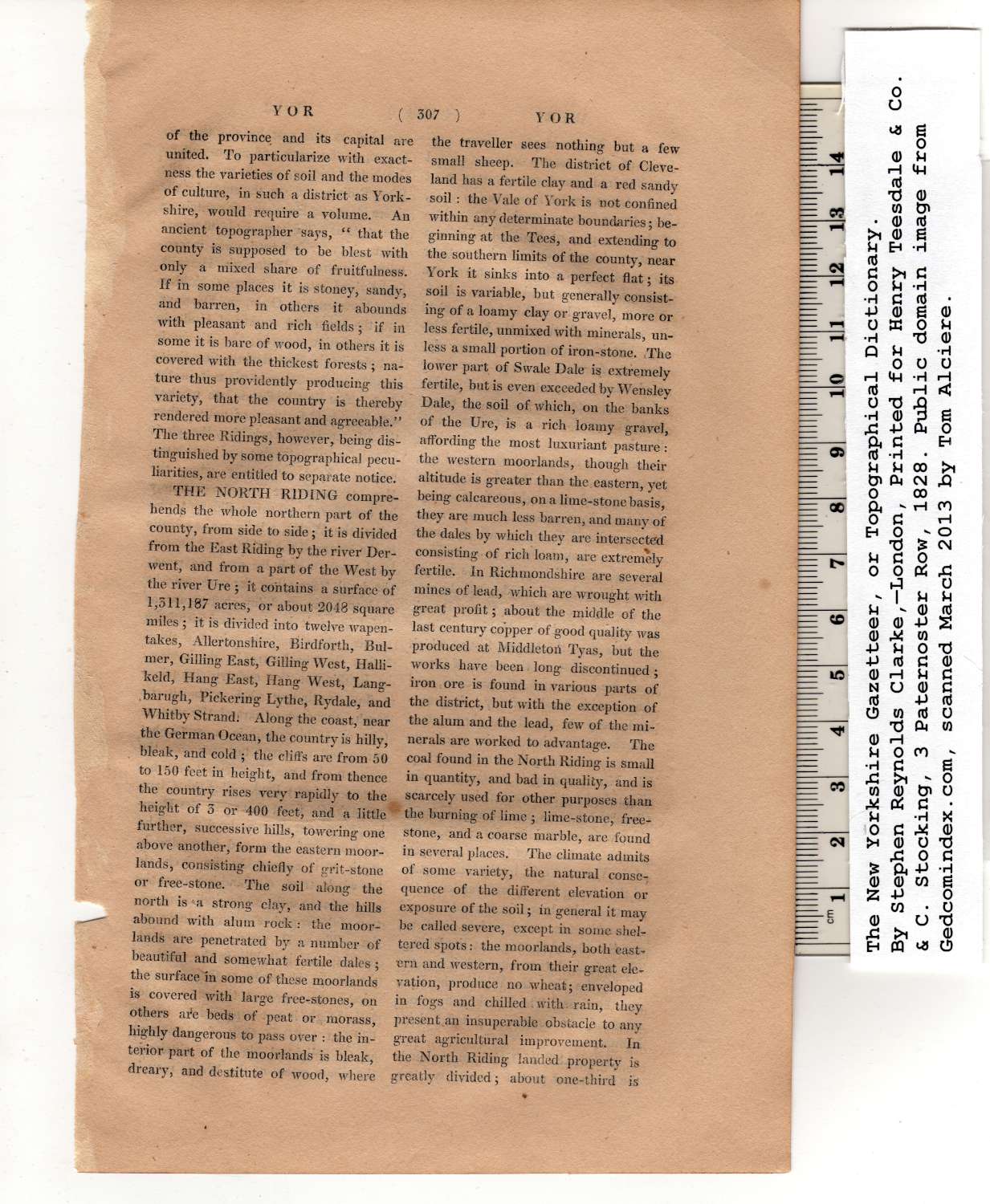|
of the province and its capital are
united. To particularize with exact-
ness the varieties of soil and the modes
of culture, in such a district as York-
shire, would require a volume. An
ancient topographer says, 44 that the
county is supposed to be blest with
only a mixed share of fruitfulness.
If in some places it is stoney, sandy,
and barren, in others it abounds
with pleasant and rich fields; if in
some it is bare of wood, in others it is
covered with the thickest forests ; na-
ture thus providently producing this
variety, that the country is thereby
rendered more pleasant and agreeable.”
The three Ridings, however, being dis-
tinguished by some topographical pecu-
liarities, are entitled to separate notice.
THE NORTH RIDING compre-
hends the whole northern part of the
county, from side to side; it is divided
from the East Riding by the river Der-
went, and from a part of the West by
the river Ure ; it contains a surface of
1,311,187 acres, or about 2048 square
miles ; it is divided into twelve wapen-
takes, Allertonshire, Birdforth, Bul-
mer, Gilling East, Gilling West, Halii-
keld, Hang East, Hang West, Lang-
barugh, Pickering Lythe, Rydale, and
Whitby Strand: Along the coast, near
the German Ocean, the country is hilly,
bleak, and cold ; the cliffs are from 50
to 150 feet in height, and from thence
the country rises very rapidly to the
height of 3 or 400 feet, and a little
further, successive hills, towering one
above another, form the eastern moor-
lands, consisting chiefly of grit-stone
or free-stone. The soil along the
north is strong clay, and the hills
abound with aluin rock : the moor-
lands are penetrated by a number of
beautiful and somewhat fertile dales ;
the surface in some of these moorlands
is covered with large free-stones, on
others afe beds of peat or morass,
highly dangerous to pass over : the in-
terior part of the moorlands is bleak,
dreary, and destitute of wood, where |
the traveller sees nothing but a few
small sheep. The district of Cleve-
land has a fertile clay and a red sandy
soil: the Vale of York is not confined
within any determinate boundaries; be-
ginning at the Tees, and extending to
the southern limits of the county, near
York it sinks into a perfect flat; its
soil is variable, hut generally consist-
ing of a loamy clay or gravel, more or
less fertile, unmixed with minerals, un-
less a small portion of iron-stone. The
lower part of Swale Dale is extremely
fertile, but is even exceeded by Wensley
Dale, the soil of which, on the banks
of the Ure, is a rich loamy gravel,
affording the most luxuriant pasture :
the western moorlands, though their
altitude is greater than the eastern, yet
being calcareous, on a lime-stone basis,
they are much less barren, and many of
the dales by which they are intersected
consisting of rich loam, are extremely
fertile. In Richmondshire are several
mines of lead, which are wrought with
great profit; about the middle of the
last century copper of good quality was
produced at MiddletoR Tyas, but the
works have been long discontinued ;
iron ore is found in various parts of
the district, but with the exception of
the alum and the lead, few of the mi-
nerals are worked to advantage. The
coal found in the North Riding is small
in quantity, and bad in quality, and is
scarcely used for other purposes than
the burning of lime ; lime-stone, free-
stone, and a coarse marble, are found
in several places. The climate admits
of some variety, the natural conse-
quence of the different elevation or
exposure of the soil; in general it may
be called severe, except in some shel-
tered spots: the moorlands, both east-
era and western, from their great ele-
vation, produce no wheat; enveloped
in fogs and chilled writh rain, they
present an insuperable obstacle to any
great agricultural improvement. In
the North Riding landed property is
greatly divided; about one-third is |
